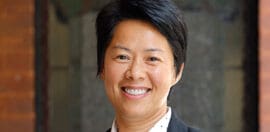Reducing the Stigma of Mental Health
1 September 2016 at 11:43 am
Marg O’Donnell AO took up the position of chair of SANE Australia in June this year. She talks about how she is finding her new role and how it compares to other boards, in this month’s Evolving Chair.
O’Donnell, who began her working life as a child welfare officer with the Department of Children’s Services in Queensland and at Walston Park Psychiatric Hospital, took up the role at SANE following a six-year tenure as chair of Breast Cancer Network of Australia.
She has held a number of senior roles including acting director for the Human Rights Commission, she was the inaugural Legal Ombudsman in Victoria, before returning to Queensland to head three government departments, including Aboriginal Affairs, Fair Trading, and the Arts. In recent times O’Donnell has chaired a number of statutory authority boards.
She said she was looking forward to working with the SANE Australia team towards a future where Australians affected by complex mental illnesses have better services, stronger social connection, less discrimination and longer lives.
In this month’s Evolving Chair she talks about reducing the stigma that surrounds mental health, growing the SANE brand and how to get the best out of your board.
What attracted you to SANE’s board?
I used to work in mental health, mental illness sort of scene and I used to be a social worker, and I worked in a big psychiatric institution in Queensland but I also worked in community health services so I had contact with people with mental health issues who lived in the community or who needed to get treatment. And then I suppose the third area that I worked in was in the human rights area, so I worked at the Human Rights Commission in the late eighties and I encountered a number of cases of people lodging discrimination complaints for lack of proper treatment, that sort of thing, of feeling discriminated because of their mental illness.
So it’s always stayed with me, an interest in mental illness and I’m very interested in the brain and all its complexities, and also I do think that people with mental illnesses, unlike say women with breast cancer, which is one of the boards I was on before, there is a lot of stigma attached to mental illness still, a great deal of stigma. Whereas having breast cancer, probably 40 or 50 years ago there was a certain stigma but it’s not so much the case now in this day and age, it’s very acceptable for someone to be quite open about their breast cancer but it’s not the same with someone, particularly with some of the severe and complex mental illnesses, schizophrenia, bipolar etc. and I see that stigma issue as a challenge.
I think one of the things that this organisation is trying to do is actually reduce that stigma so that people with mental illnesses can have more rewarding lives. So you are probably picking up, I like a bit of a challenge and I see this area as having lots of challenges, there’s lots we can do.
You were recently appointed chair of SANE after six years as chair of Breast Cancer Network of Australia. How does it compare?
It is interesting. The first main arcs of the work we do are very similar, interestingly. They are both health focused Not for Profit organisations. They both have a comparative service delivery, they both have needs to fundraise to supplement their income. Because they get some government money but basically you have got to get out there into the community to bring money in to help support the work of the organisation. They both are keen on advocacy, that is either speaking to governments and speaking to the health professionals and trying to get better deals for our clients. Also they both very much focus on the community around the person with the illness, so in SANE it’s the family and friends of the person with the mental illness, in breast cancer it was the spouse and kids and family of women experiencing breast cancer.
So there is a lot of similarity. I suppose the differences boardwise, which are interesting, is we had a lot more women on the Breast Cancer board, as you can imagine. So it was very much predominately women board members. At one stage, I’m not quite sure what it is now, more than half of the board members had had breast cancer, including myself as chair, and that was something we looked for. If all else was equal and we had somebody who looked a very promising board member we would look for someone who either had had breast cancer, or in the case of our two men that we had on, one was a surgeon oncologist and the other, his wife had experienced breast cancer and he was a senior partner with PricewaterhouseCoopers.
So, pretty much everyone on that board had a connection with breast cancer, a very close connection, whereas with SANE, there are a number of us like me who have got family members who have had various, serious issues in relation to mental health, but I’ve never been say a carer or really up close and personal in the way that I was in the Breast Cancer scene.
But we do have clinicians and we do have a person on our SANE board who has, what we call lived experience of mental illness as a board contributor. So the core positions are similar, the gender spread, there are more blokes on the SANE board, and of course the clientele for SANE is much more spread across both genders, whereas Breast Cancer was very much female, although men do experience breast cancer, they do so in very small percentages. But look, [they are] both national boards, both wanting a spread of skills and expertise and some geographic spread, I am in Brisbane, we’ve got a couple of board members from Sydney, some from Melbourne, one from regional Australia, currently one from Perth, [which is] similar also to Breast Cancer. So if you are going to be a national organisation I think if you can you should try and get a spread and not just have yourself located either in the Sydney or Melbourne sort of apex.
What is the structure of SANE’s board?
I think there are about 10 members. Some of them have been on for quite some time, as I said, most of them have a strong connection with a lived experience, so there’s a couple of people who have close family members. As you know Anne Deveson who founded SANE 30 years ago, it’s our 30th anniversary this year, she had a son who had schizophrenia and… he committed suicide, and after he died she set up Schizophrenia Australia, which has then sort of morphed into SANE Australia.
So I think we seem to have attracted, particularly men in the business area, who are able to provide some governance guidance and also help with their networks to get some funding for us but who also have a very close association with the lived experience of mental illness, so we have a couple of them. As I said we have a GP who sees quite a lot of her patients come across her desk and then she has to refer on, people with mental illnesses. We’ve got a sort of consultant / non executive director person, based in Sydney, a woman who is very well networked and knows a lot about governance, because I think we also need people who know how to help CEOs run organisations and who will mark sort of all the governments requirements because we are of course registered with the ACNC and we have various compliance obligations to meet.
We’ve got a guy, Colin, who is the chair of a carers organisation in Victoria, and that’s a sort of peak organisation of carer groups, who care for people with mental illnesses. And we will always maintain, I think in fact our constitution says that we should endeavour to always maintain, at least one position on the board of someone who has had that experience, and who brings to our deliberations a consideration of the needs of the family and close friends of people with mental illnesses. We have a guy called Jack O’Connell who is our treasurer. I don’t know whether Jack has any personal connections to mental illness but he’s got very good personal connections to running the money, he looks after our budget and oversights that, chairs the finance and audit committee and is very well connected in the business community and brings very good financial smarts to the organisation as well.
What are your board’s current priorities?
There is a couple of them. Again, you have to forgive me, I’m very new. So I don’t want to preempt too much except to say it seems that we are looking obviously at growth, sounds like Malcolm Turnbull “jobs and growth”. We’ve got a fantastic online forum that is offered to anybody at anytime in Australia, they can go online and chat and talk to other people and get sort of peer support, now we want to grow that. It’s terrific, and it’s doing well but it could be taken up by a lot more people, so some of that relates really to promoting and extending our brand and I would say that would be a real priority.
Within the sector we are well known but we don’t have the profile of say the beyondblue or Black Dog organisations and we would like to, we would like to be as well known as them so that people will use us and make use of the services. So brand growth. Another priority is fundraising. Fundraising in Not for Profit is always a fraught business and it is never settled, if you know what I mean, you have just got to keep thinking creatively, thinking of new ways to raise funds, whether it be through trusts, through philanthropy, through activity, through events, through, if you are really lucky getting some fantastically generous corporate sponsor who might want to partner with us, so we don’t have that latter, we do have a lot of supporters and a lot of individuals who support us but I would say the fundraising, particularly to help us expand and enhance our work would be a key issue. And the other thing I think, is what I mentioned earlier, is processes to do stigma reduction, we send speakers with lived experiences into workplaces and we talk to workplace managers etc about how to cope with somebody who works in your organisation who is experiencing a mental illness, how to look after them and not discriminate against them. And part of that is very practical advice, but part of that also is just getting someone who has experienced mental illness to go and talk to workers in an organisation so they can actually see the humanity of somebody who has had a mental illness and not see them as, you know, someone who’s not worthy of import or compassion.
So I would say stigma reduction is another big focus that we would be doing. And also it is routine, but it is very important for us at the moment, we are really redoing our strategic plan, really trying to focus on what are our major areas of difference and what is our point of differentiation with the other mental health services so we can get that right and not duplicate what we’re doing.
Does your board believe collaboration between organisations is important?
Absolutely and I do too. This is somewhat of a crowded space. There is a lot of helping services around the place, particularly Not for Profit helping services, there is phone services, online services, there’s people involved in caring services and there are also other advocacy services that speak to the government when they want some changes etc. It would be crazy, I believe, not to band together when you need to, both for a particular project but also maybe long term projects or long term collaborations. We are all very supportive of that. I can’t really discuss it but we are having conversations right now around a possible major collaboration with a very large player in this space.
How important is a board’s relationship with the chief executive officer?
It is vital, it is totally vital. I [did an] Australian Institute of Company Directors course …and if I didn’t know before, I certainly did after doing that course, that one of the keys roles and functions of the board, particularly the chair, is to manage that relationship to provide support and guidance to the CEO and to have a very productive working relationship. I think if the relationship between the board and the CEO is not good or breaks down then you are in deep, deep trouble. So I think that relationship is incredibly important and I think certainly stepping into SANE there is an excellent relationship between the board and the CEO, one of mutual respect and collaboration and help and I see no reason why that won’t continue. And my preferred style is to stay close to my CEO, have online and phone conversations because we don’t live in the same city, and to catch up between board meetings, with face to face meetings when we possibly can. So it’s a very, very critical relationship, because of course we have to do the performance review of the CEO every year and in this case give feedback about how they’re going and set new targets and goals and that sort of thing with them. So it’s very important.
You have offered your expertise to a number of boards during your career, what is the biggest piece of advice you would offer to someone chairing a NFP board?
That’s a hard one. I would say two things. You will need to be prepared to really put a lot of time into it. I remember hearing that a good chair puts three times the amount of time into the organisation or to the board and organisation than the other board members, and I think that is probably true, sometimes in my experience and so for example now I think I’m putting even more than three times that.
So, one is, if you’re going to do it, you have got to do it properly, and that involves your time. It involves your time not only in working with the CEO, listening to the CEO, that’s the other thing I think, not being into micromanaging the organisation but taking advice and listening to what the CEO is doing and then reflecting back, or supporting, finding ways to help expedite what the CEO wants to do, obviously within the framework of our own constitution and stuff.
So putting the time, working closely, you have got to listen to and work closely with your CEO, and I suppose, rolling that around you have got to listen to your other board members, I mean some board members can just, how can I put it, not really contribute as much as they might and sometimes that not their fault necessarily, I think the chair needs to include people and actually speak to every board member, apart from in board meetings, to sort of pull out the best of them to find out, why are you on this board and what is it you think you can offer and can we explore that a bit further, how can we get the best we possibly can out of you. So that would be the advice I would give someone, give the time, work closely with the CEO and enthuse and use your board members to the utmost of their abilities.









Never, ever does one say there is a “stigma” to mental illnesses. One says there are people who hold that prejudice and one educates them.
Harold A. Maio
khmaio@earthlink.net